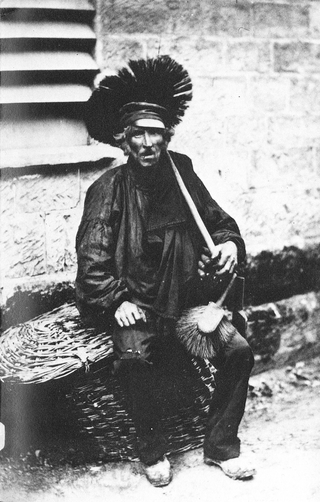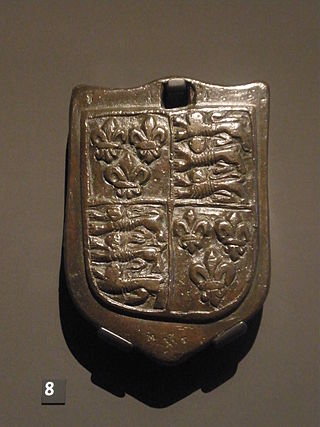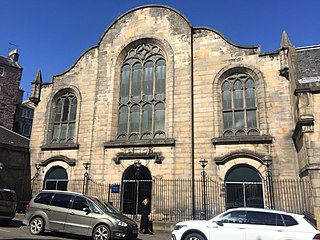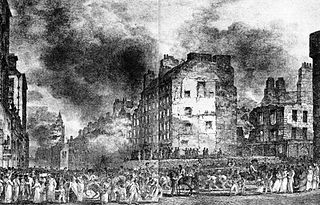Related Research Articles

Curling is a sport in which players slide stones on a sheet of ice toward a target area which is segmented into four concentric circles. It is related to bowls, boules and shuffleboard. Two teams, each with four players, take turns sliding heavy, polished granite stones, also called rocks, across the ice curling sheet toward the house, a circular target marked on the ice. Each team has eight stones, with each player throwing two. The purpose is to accumulate the highest score for a game; points are scored for the stones resting closest to the centre of the house at the conclusion of each end, which is completed when both teams have thrown all of their stones once. A game usually consists of eight or ten ends.

Archibald Campbell Tait was an Archbishop of Canterbury in the Church of England and theologian. He was the first Scottish Archbishop of Canterbury and thus, head of the Church of England.

The Royal Mile is a succession of streets forming the main thoroughfare of the Old Town of the city of Edinburgh in Scotland. The term was first used descriptively in W. M. Gilbert's Edinburgh in the Nineteenth Century (1901), describing the city "with its Castle and Palace and the royal mile between", and was further popularised as the title of a guidebook by R. T. Skinner published in 1920, "The Royal Mile (Edinburgh) Castle to Holyrood(house)".

Percivall Pott was an English surgeon, one of the founders of orthopaedics, and the first scientist to demonstrate that a cancer may be caused by an environmental carcinogen, namely chimney sweeps' carcinoma. Many diseases are his namesake including Pott's fracture, Pott's disease of the spine, and Pott's puffy tumor. It is believed that Pott's standard of living contributed to the rise of the surgeon within social standings.

Henry Dundas, 1st Viscount Melville, PC, FRSE, styled as Lord Melville from 1802, was the trusted lieutenant of British prime minister William Pitt and the most powerful politician in Scotland in the late 18th century.

A chimney sweep is a person who clears soot and creosote from chimneys. The chimney uses the pressure difference caused by a hot column of gas to create a draught and draw air over the hot coals or wood enabling continued combustion. Chimneys may be straight or contain many changes of direction. During normal operation, a layer of creosote builds up on the inside of the chimney, restricting the flow. The creosote can also catch fire, setting the chimney alight. The chimney must be swept to remove the soot.

A burgh is an autonomous municipal corporation in Scotland and England, usually a city, town, or toun in Scots. This type of administrative division existed from the 12th century, when King David I created the first royal burghs. Burgh status was broadly analogous to borough status, found in the rest of the United Kingdom. Following local government reorganisation in 1975, the title of "royal burgh" remains in use in many towns, but now has little more than ceremonial value.

The stone or stone weight is an English and British imperial unit of mass equal to 14 pounds (6.35 kg). The stone continues in customary use in the United Kingdom for body weight.

William Collins was a Scottish schoolmaster, editor and publisher who founded William Collins, Sons, now part of HarperCollins. William Collins was born at Eastwood, Renfrewshire, on 12 October 1789. He was a millworker who established a company in 1819 for printing and publishing. The business eventually published pamphlets, sermons, hymn books and prayer books as well as a wide range of office products. By 1824 he had produced the company's first dictionary, the Greek and English Lexicon. He was instrumental in bringing Thomas Chalmers from Kilmany to Glasgow. He also obtained a licence to publish the Bible in the 1840s. He was promoter of Scotland's first temperance movement. He founded the Glasgow Church Building Society which created 20 new churches. He died on 2 January 1853 at Rothesay, Buteshire.

Scottish or Scots units of measurement are the weights and measures peculiar to Scotland which were nominally replaced by English units in 1685 but continued to be used in unofficial contexts until at least the late 18th century. The system was based on the ell (length), stone (mass), and boll and firlot (volume). This official system coexisted with local variants, especially for the measurement of land area.

The Tron Kirk is a former principal parish church in Edinburgh, Scotland. It is a well-known landmark on the Royal Mile. It was built in the 17th century and closed as a church in 1952. Having stood empty for over fifty years, it was used as a tourist information centre for several years in the mid 2000's and, more recently, was the site of the Edinburgh World Heritage Exhibition and John Kay’s book and gift shop.

The Royal Company of Merchants of the City of Edinburgh, previously known as the Merchant Company of Edinburgh is a mercantile company and Guild officially recognised in 1681, but dating back to at least 1260. The Company, or Confraternity, was created to publicly represent, and protect the trading rights, of the merchants of the royal burgh of Edinburgh. Today, it continues to serve as a forum for businesses people and professionals operating in the City of Edinburgh. It also carries out a significant amount of charitable and educational work.

Chimney sweeps' cancer, also called soot wart or scrotal cancer, is a squamous cell carcinoma of the skin of the scrotum. It has the distinction of being the first reported form of occupational cancer, and was initially identified by Percivall Pott in 1775. It was initially noticed as being prevalent amongst chimney sweeps. The disease has also been seen in men exposed to mineral oil and those who worked with coal distillates.

Lady Yester's Kirk was a parish church of the Church of Scotland and one of the burgh churches of Edinburgh. Founded in 1647, it served the south-eastern part of Edinburgh's Old Town until its union with Greyfriars Kirk in 1938.

Andrew Hunter of Barjarg FRSE (1743–1809) was a Minister in Edinburgh. He was Moderator of the General Assembly of the Church of Scotland in 1792, was Professor of Divinity at the University of Edinburgh and a Founding Fellow of the Royal Society of Edinburgh.

Thomas Elder of Forneth, was a Scottish wine merchant who served as Lord Provost of Edinburgh from 1788 to 1790.
The Tron Riot occurred in Edinburgh, Scotland in 1811–12. It took place in the city's Old Town, in the vicinity of the Tron Kirk. On the night of New Year's Eve and during the early hours of the next day, a group of young men, including the Keellie Gang, attacked and robbed wealthier passers-by. One police officer was killed in the riot. Sixty-eight youths were arrested, and five were sentenced to death.

The Great Fire of Edinburgh was one of the most destructive fires in the history of Edinburgh. It started on Monday, 15 November 1824, and lasted for five days, with two major phases.

Chalton Street Market is a street market in Camden, North London.

The Melville Monument is a large column in St Andrew Square, Edinburgh constructed between 1821 and 1827 as a memorial to Scottish statesman Henry Dundas, 1st Viscount Melville.
References
- 1 2 Paterson, James (1885). Kay's Edinburgh Portraits: A Series of Anecdotal Biographies Chiefly of Scotchmen. Hamilton, Adams. p. 130.
- ↑ "The Mystery of the Artist(s)". Parliament Square, Edinburgh. 2019-11-13. Retrieved 2023-11-10.
- ↑ Council, Edinburgh (Scotland) Town (1811). Regulations for the Tronmen, Chimney-sweepers, and Firemen of Edinburgh. The Council.
- 1 2 "Dictionaries of the Scots Language:: SND :: tron" . Retrieved 2023-11-10.
- 1 2 "Kay's Edinburgh Portraits". electricscotland.com. Retrieved 2023-11-10.